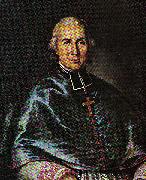La Peinture à l'huile en gros de Chine & Encadre |
|||||||||||

|
|||||||||||
|
|
|
||||||||||||||
|
Antoine Plamondon
(ca. 1804-1895) was a Canadian artist who painted mainly portraits and religious images in 19th-century Quebec. Plamondon was born in 1804 (or 1802) at L'Ancienne-Lorette, Quebec, the son of the village grocer. He went to school in Saint-Roch, a suburb of Quebec City, after which he was apprenticed to Joseph Legare (1795-1855), a picture restorer and amateur painter. In 1826 Plamondon travelled to Paris where he studied with classical portraitists such as Paulin Guerin (1783-1855). Works from this period are scarce. In 1830, after the Louis-Philippe uprisings, Plamondon returned to Quebec. While his portraits were of living subjects, many of his religious paintings (commissioned by various churches and religious orders around Quebec City) were based on engravings of old masters. His portrait work was notable for his full-face, close-up, and tightly comosed style as well as a concentration on the latest style of clothing. His later portraits showed more roundness in the modelling and far more space in the composition. By 1850 Plamondon had moved to the country at Neuville, with his mother, a brother, and a sister, where he lived until the 1890s. Much of his work during this period were religious paintings, copies of old masters, done for local churches. Plamondon never married. He was a lifelong monarchist and supporter of the Conservative Party, a friend of Sir George-Étienne Cartier and Sir Étienne Tache, but broke with the Conservatives over the execution of Louis Riel. His 1882 self-portrait was probably his last work He died in Neuville in 1895. |
||||||||||||||
|
|
||||||||||||||
|
||||||||||||||
|
|
||||||||||||||
| Antoine Plamondon
(ca. 1804-1895) was a Canadian artist who painted mainly portraits and religious images in 19th-century Quebec. Plamondon was born in 1804 (or 1802) at L'Ancienne-Lorette, Quebec, the son of the village grocer. He went to school in Saint-Roch, a suburb of Quebec City, after which he was apprenticed to Joseph Legare (1795-1855), a picture restorer and amateur painter. In 1826 Plamondon travelled to Paris where he studied with classical portraitists such as Paulin Guerin (1783-1855). Works from this period are scarce. In 1830, after the Louis-Philippe uprisings, Plamondon returned to Quebec. While his portraits were of living subjects, many of his religious paintings (commissioned by various churches and religious orders around Quebec City) were based on engravings of old masters. His portrait work was notable for his full-face, close-up, and tightly comosed style as well as a concentration on the latest style of clothing. His later portraits showed more roundness in the modelling and far more space in the composition. By 1850 Plamondon had moved to the country at Neuville, with his mother, a brother, and a sister, where he lived until the 1890s. Much of his work during this period were religious paintings, copies of old masters, done for local churches. Plamondon never married. He was a lifelong monarchist and supporter of the Conservative Party, a friend of Sir George-Étienne Cartier and Sir Étienne Tache, but broke with the Conservatives over the execution of Louis Riel. His 1882 self-portrait was probably his last work He died in Neuville in 1895. Portrait_of_Monseigneur_Joseph_Signay Oil on canvas; 76 x 63 cm. 1836 cjr Oil on canvas; 76 x 63 cm. 1836 cjr |
||||||||||||||
|
Related Paintings to Antoine Plamondon :. |
||||||||||||||
|
|
||||||||||||||
|
|
||||||||||||||
|
CONTACTER DES Etats-Unis |







